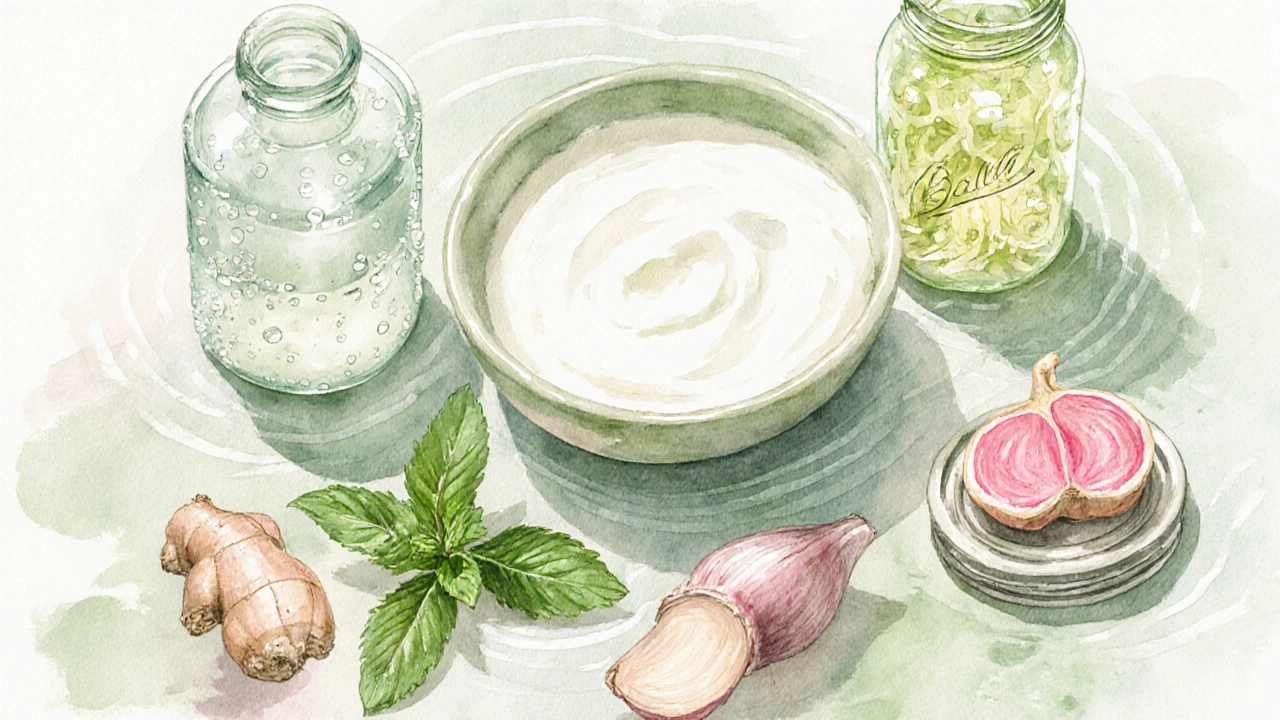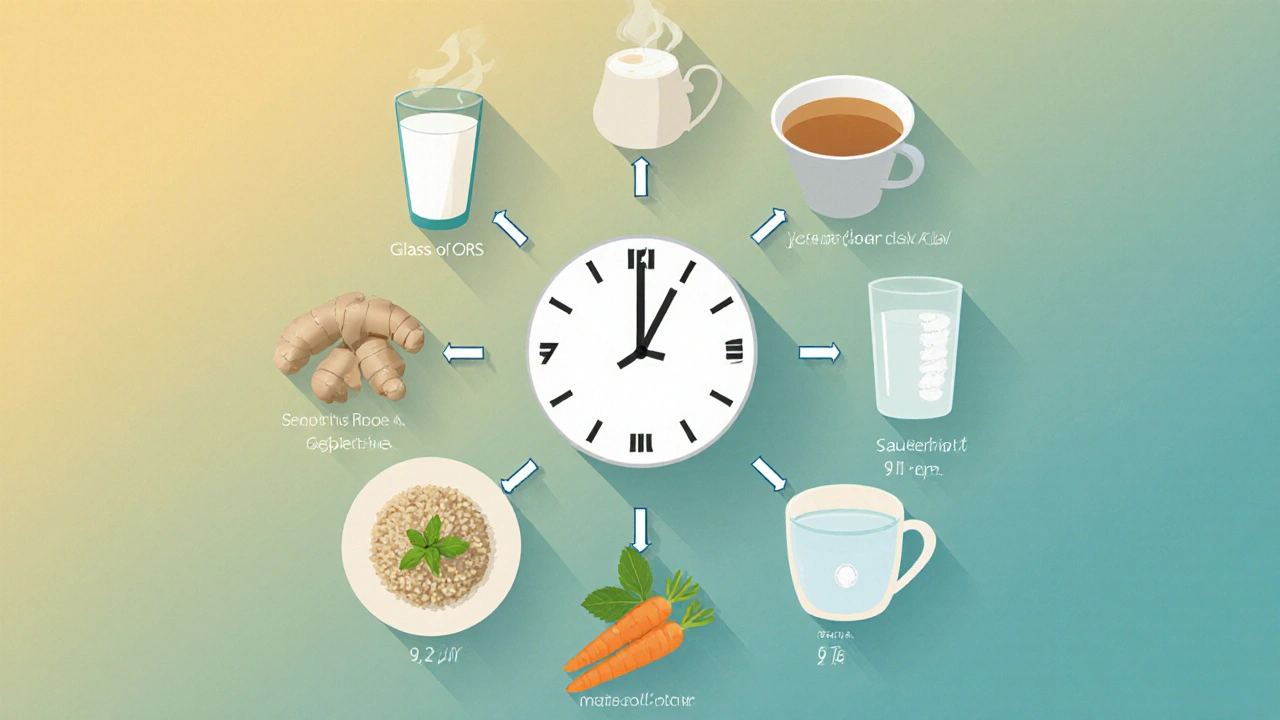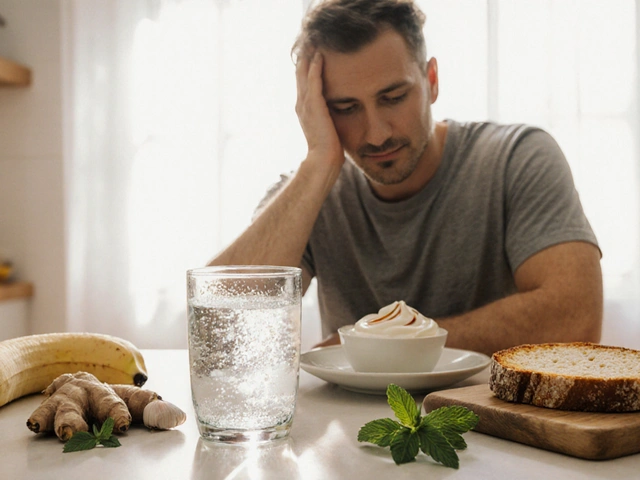Enteric Infection Symptom Relief Planner
Your Personalized Relief Plan
Dealing with an Enteric infection is uncomfortable enough without a trip to the doctor for every ache. Luckily, many people can tame the worst symptoms at home using simple, evidence‑backed tricks. Below you’ll find a step‑by‑step guide that covers hydration, gut‑friendly foods, soothing herbs, and everyday hygiene habits that keep the infection from getting the best of you.
What Exactly Is an Enteric Infection?
An Enteric infection is any bacterial, viral, or parasitic invasion of the gastrointestinal (GI) tract. Common culprits include Salmonella, E. coli, norovirus, and Giardia. The infection typically attacks the intestines, causing inflammation, excess fluid secretion, and disrupted digestion.
Because the gut lines are thin and highly vascular, even a small imbalance can translate into noticeable nausea, cramping, and watery stools. Recognizing the cause helps you choose the right home remedy, but the ultimate goal is to keep the body hydrated, restore normal flora, and calm the gut wall.
Typical Symptoms and When to Seek Professional Care
- Frequent watery diarrhea (often 3‑6 times a day)
- Stomach cramps or bloating
- Nausea or occasional vomiting
- Low‑grade fever (under 101°F/38.3°C)
- Signs of dehydration: dry mouth, dizziness, reduced urine output
If symptoms last more than three days, you develop blood in the stool, cannot keep fluids down, or belong to a high‑risk group (young children, elderly, pregnant, immunocompromised), call a health professional. For most otherwise healthy adults, the following home strategies can alleviate discomfort while the immune system clears the pathogen.
Why Home Remedies Work
Most enteric infections are self‑limiting; the body eventually eradicates the offending microbe. Home care speeds recovery by:
- Preventing dehydration, the biggest complication of diarrhea.
- Replenishing beneficial gut bacteria that get flushed out.
- Providing anti‑inflammatory and anti‑nausea compounds from herbs and foods.
- Reducing exposure to irritants that could prolong inflammation.
When you combine these tactics, you give your gut a chance to heal without needing prescription medicines.

Hydration: The Cornerstone of Recovery
Loss of fluids and electrolytes is the most dangerous side effect of an Enteric infection. Rehydration can be as simple as sipping clear liquids, but for faster electrolyte balance, consider an Oral rehydration solution (ORS).
Commercial ORS packets are cheap and widely available, but you can make a reliable DIY version:
- 1 litre of clean water
- 6 teaspoons of sugar
- ½ teaspoon of salt
Stir until dissolved and drink in small sips every 10‑15 minutes. Alternatives that also supply electrolytes include coconut water, low‑sodium vegetable broth, and electrolyte‑enhanced sports drinks (choose those without excessive sugar).
Probiotic Power: Restoring Good Bacteria
During a bout of diarrhea, the healthy microbes that normally keep the gut in balance are flushed out. Introducing a Probiotic helps re‑colonize the intestines and shortens the illness by up to 30% according to a 2023 clinical review.
Best probiotic foods for an enteric infection include:
- Yogurt with live cultures (look for "contains Lactobacillus" on the label). Aim for a half‑cup 2‑3 times daily.
- Kefir - a fermented milk drink that packs 10‑20 different strains.
- Fermented vegetables such as sauerkraut or kimchi (start with a tablespoon to avoid excess fiber).
If dairy bothers you, try a non‑dairy kefir or a probiotic capsule containing at least 10billion CFU per dose.
Herbal Soothers: Ginger, Peppermint, and Garlic
Several kitchen herbs have anti‑nausea, antispasmodic, or antimicrobial properties that calm the gut.
Ginger (Zingiber officinale) contains gingerols that reduce nausea and gastric emptying time. A simple ginger tea recipe:
- Slice 1‑2cm of fresh ginger root.
- Steep in 250ml boiling water for 5‑10 minutes.
- Add a teaspoon of honey if you need sweetness.
Drink up to three cups a day.
Peppermint tea relaxes smooth muscle in the intestines, easing cramping. Use 1‑2 teaspoons of dried peppermint leaves per cup of hot water; steep for 7 minutes.
Garlic (Allium sativum) has allicin, a natural antibacterial agent. Chew a raw clove or add minced garlic to a light broth to reap its benefits without overwhelming the stomach.
Dietary Adjustments: The BRAT Foundation and Beyond
The classic BRAT diet (Bananas, Rice, Applesauce, Toast) works because it offers bland, low‑fiber foods that are easy to digest and help bulk up stools. However, modern research suggests a slightly more varied approach can speed recovery:
- Bananas: provide potassium lost in diarrhea.
- White rice or plain boiled potatoes: supply simple carbs without irritating the gut.
- Applesauce (unsweetened): gentle source of pectin, which can firm stools.
- Plain toast or crackers: add a bit of bulk.
- Steamed carrots or zucchini: low‑fiber veg that adds micronutrients.
Avoid fatty, fried, spicy, or highly acidic foods until symptoms ease. Alcohol and caffeine can worsen dehydration, so skip them for at least 48hours.

Hygiene Practices to Prevent Re‑Infection
Even after symptoms subside, a stray pathogen can linger on surfaces. Follow these quick steps:
- Wash hands with soap and warm water for at least 20seconds after using the bathroom and before handling food.
- Disinfect kitchen counters and bathroom fixtures with a bleach solution (1tbsp bleach per litre of water) daily.
- Avoid sharing utensils, towels, or water bottles with sick household members.
- If you’re caring for a child with diarrhea, use a separate bathroom if possible.
Quick Home‑Remedy Checklist
| Remedy | Main Benefit | Typical Dose | Key Ingredient(s) |
|---|---|---|---|
| Oral Rehydration Solution | Restores fluids & electrolytes | 200‑250ml every 15min | Water, glucose, sodium chloride |
| Yogurt (live cultures) | Re‑populates gut bacteria | ½cup 2‑3×/day | Lactobacillus, Bifidobacterium |
| Ginger Tea | Reduces nausea & cramps | 1‑2 cups/day | Gingerols |
| Peppermint Tea | Relieves intestinal spasms | 1‑2 cups/day | Menthol |
| BRAT‑Based Meals | Gentle energy source, stool bulking | Every meal until recovery | Banana, rice, applesauce, toast |
Putting It All Together: A 24‑Hour Plan
- Morning: Prepare a glass of ORS, sip slowly. Have a half‑cup of probiotic yogurt and a slice of toast.
- Mid‑morning: Brew ginger tea, sip while resting.
- Lunch: Plain boiled rice with a spoonful of steamed carrots. Add a minced‑garlic broth if you tolerate it.
- Afternoon: Refill ORS, consider a handful of sauerkraut if you feel less crampy.
- Evening: Peppermint tea, a small banana, and a second serving of yogurt.
- Before Bed: Light warm water with a pinch of salt.
Monitor urine color (aim for pale yellow) and stool frequency. If you notice improvement within 48hours, continue the regimen until you’ve been symptom‑free for at least two days.
Frequently Asked Questions
Can I use over‑the‑counter anti‑diarrheal meds with home remedies?
Occasionally, a short course of loperamide can ease severe cramping, but it also slows the body’s natural clearance of the pathogen. If you choose to combine it, limit use to 24hours and continue hydration and probiotic support.
Is it safe to give probiotics to children with an enteric infection?
Yes, age‑appropriate probiotic yogurt or a pediatric‑specific probiotic powder can be given to kids over 6months. It helps restore gut flora without side effects.
How long should I stay on the BRAT diet?
Stick with bland foods until stools return to normal consistency (usually 2‑3 days). Then gradually re‑introduce fiber‑rich fruits, whole grains, and lean proteins.
Does drinking coffee worsen diarrhea?
Coffee is a diuretic and can irritate the stomach lining, so it’s best to avoid it while you’re dehydrated. Opt for herbal teas or water instead.
When is it time to see a doctor?
Seek medical help if you have blood in stool, a fever above 101°F (38.3°C) that lasts more than 24hours, severe vomiting that prevents fluid intake, or signs of dehydration despite oral rehydration.
By following these home remedies for enteric infection, you give your body the tools it needs to recover quickly, stay hydrated, and rebuild a healthy gut microbiome-all without rushing to the pharmacy for prescription drugs.


liza kemala dewi
October 5, 2025 AT 18:48It is a profound, albeit often overlooked, truth that the human organism thrives on the principle of equilibrium, particularly when faced with a transient assault such as an enteric infection. Hydration, therefore, is not merely a recommendation but a cornerstone of physiological homeostasis; the loss of aqueous volume and electrolytes, if left unchecked, can precipitate a cascade of systemic disturbances that extend far beyond the gastrointestinal tract. By employing a well‑balanced oral rehydration solution-comprising precise ratios of glucose and sodium-one capitalizes on the sodium‑glucose co‑transport mechanism that facilitates optimal fluid absorption in the small intestine. Moreover, the restoration of the gut microbiota through the judicious consumption of probiotic‑rich substrates, such as live‑culture yogurt, kefir, or fermented vegetables, serves to re‑establish the symbiotic relationship that underpins mucosal immunity. The scientific literature of the past decade furnishes robust evidence that probiotic supplementation can truncate the duration of diarrhoeal episodes by up to thirty percent, a statistic that ought to inspire confidence in patients seeking non‑pharmacologic relief. In parallel, the incorporation of gentle, non‑irritating foods, epitomized by the contemporary adaptation of the BRAT diet, supplies fermentable carbohydrates that are readily absorbed, thereby reducing luminal osmotic load. Bananas contribute potassium, a critical intracellular cation depleted during diarrhoea, while plain rice offers a bland source of glucose that does not exacerbate motility. Herbal adjuncts, such as ginger and peppermint, contain bioactive compounds-gingerols and menthol respectively-that have been shown in controlled trials to attenuate nausea and smooth‑muscle spasm, providing symptomatic comfort without compromising the body’s innate clearance mechanisms. It is also prudent to avoid substances that may aggravate the mucosal lining, including caffeine, alcohol, and excessively fatty or spicy fare, as these can perpetuate hypersecretion and delay healing. Equally important is the maintenance of adequate sleep and stress reduction, as cortisol elevations can impair gut barrier integrity and immune responsiveness. Regular, light physical activity, such as short walks, promotes intestinal peristalsis without imposing undue strain, facilitating the orderly transit of contents. Monitoring of urine colour and frequency provides a practical, bedside indicator of hydration status, allowing timely adjustments to fluid intake. Should any red flag appear-persistent high‑grade fever, blood‑tinged stool, or inability to retain oral fluids-prompt medical evaluation remains indispensable, for the risk of severe dehydration or invasive pathology escalates sharply. Ultimately, by integrating these evidence‑based home measures, the individual not only alleviates discomfort but also honors the body’s intrinsic capacity for self‑repair. Thus, a holistic approach that respects both the biochemical and the psychosocial dimensions of illness yields the most resilient recovery trajectory.
Jay Jonas
October 10, 2025 AT 06:51I swear, when the stomach starts doing its own drum solo, I’m literally ready to throw the whole kitchen sink at it, because nothing feels worse than the helpless churn of gut turmoil; the nausea, the cramping, it’s like a roller‑coaster that just won’t stop, and I’m definitely not gonna let it win. The moment I sip that ginger tea, it’s like a rescue mission for my taste buds, and the peppermint follows like a cool breeze after a scorching day, soothing those spasms with a whisper of relief. Even the simplest ORS, that salty‑sweet concoction, feels like a lifeline tossed into a stormy sea of dehydration, and I’m grateful for every droplet that actually stays down. Sure, the BRAT diet sounds old‑fashioned, but in my experience it’s the trusty sidekick that steadies the ship when the waves get too wild. So, while the body does its own battle, these home remedies are the loyal allies that keep the morale high and the symptoms in check.
Liam Warren
October 14, 2025 AT 18:54From a pathophysiological standpoint, enteric pathogens induce an osmotic gradient across the intestinal epithelium, precipitating water efflux and resulting in diarrheal output; concomitantly, the epithelial tight junctions become dysregulated, facilitating translocation of luminal antigens and amplifying the inflammatory cascade. Therapeutic modulation via isotonic ORS leverages the SGLT1 transporter to enhance sodium‑glucose co‑absorption, thereby mitigating net fluid loss. Probiotic administration introduces competitive exclusion mechanisms, producing bacteriocins that suppress pathogen colonization while also upregulating mucosal IgA synthesis. Phytochemicals in ginger (gingerols) and peppermint (menthol) act on the enteric nervous system, attenuating visceral hypersensitivity through TRPA1 and TRPM8 channel antagonism. Collectively, these interventions constitute a multimodal, evidence‑based protocol that addresses fluid balance, microbial ecology, and neuromodulation without recourse to antimicrobial pharmacotherapy.
Brian Koehler
October 19, 2025 AT 06:58Indeed, the comprehensive strategy you outlined, dear colleague, is nothing short of exemplary, – a harmonious blend of rehydration, probiotics, and phytotherapy, all meticulously aligned with the underlying physiology, – and it underscores the indispensable role of patient‑centric care, especially in the context of self‑managed enteric infections, – kudos for such a thorough exposition!
Aparna Dheep
October 23, 2025 AT 19:01One must remember that neglecting proper hydration is simply irresponsible, especially when reliable remedies are at hand.
Nicole Powell
October 28, 2025 AT 06:04Stop ignoring the ORS; it works.
Ananthu Selvan
November 1, 2025 AT 18:08This so‑called “holistic” advice is just a collection of buzzwords, nobody needs a lecture on basic rehydration when the facts are obvious.
Nicole Chabot
November 6, 2025 AT 06:11Hey, thanks for the detailed guide! It’s really helpful and easy to follow.
Sandra Maurais
November 10, 2025 AT 18:14Your appreciation is noted, and it is evident that the structured approach aligns with best practices 😊. Nevertheless, adherence to the outlined protocol remains essential for optimal outcomes 📊.
Michelle Adamick
November 15, 2025 AT 06:18Stay proactive, keep your electrolyte balance on point, and remember that gut health is a marathon, not a sprint 🏃♀️💧. Consistency with ORS, probiotics, and soothing herbs will keep your system in the green zone ✅.